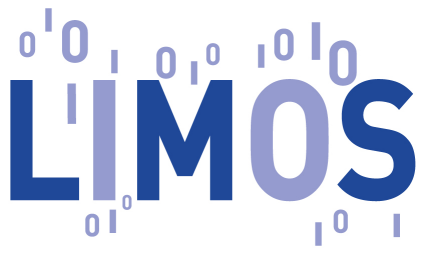Thème Algorithmique, Graphes, Complexité
Présentation
Les thèmes abordés par Algorithmes, Graphes et Complexité sont principalement : (1) des propriétés structurelles sur les graphes/treillis et leurs conséquences algorithmiques, et (2) l'algorithmique géométrique avec un intérêt particulier sur la géométrie discrète.
Il est commun dans l'étude d'objets combinatoires d'appliquer la technique du "Diviser pour Mieux régner" de Descartes, ie, définir des opérations sur les objets et ensuite décomposer à l'aide des opérations pour tenter d'expliquer la complexité des objets étudiés. Le groupe a une expertise dans les décompositions des graphes et des treillis, et leurs applications algorithmiques. Des exemples de décompositions étudiées sont par exemple la décomposition arborescente et la largeur de rang dont le but est d'étudier les classes de graphes qui ressemblent à des arbres, mais aussi des décompositions basées sur des séparateurs comme les cliques ou stables ou skew-partition avec des applications en coloration de graphes. Les décompositions de treillis étudiés peuvent être des constructions récursives basées sur la copie d'ensembles convexes ou de posets colorés. Voici quelques applications algorithmiques des décompositions étudiées :
- Les algorithmes d'énumération dans les (hyper)graphes et treillis. Le groupe est reconnu dans les problèmes d'énumération de sous-ensembles de sommets satisfaisant une certaine propriété. On peut citer par exemple l'équivalence entre l'énumération des dominants minimaux et le célébre problème des transversaux minimaux.
- La représentation de treillis. Cette question est abordée dans le cadre de la Dualisation des treillis, une généralisation du problème des transversaux minimaux.
- Problèmes d'optimisation. Des exemples de problèmes d'optimisation étudiés sont la coloration de graphes, des problèmes de domination, différentes formes d'homorphisme de graphes. Le groupe s'intéresse aussi bien à l'obtention de bornes inf/sup sur des paramètres comme le nombre chromatique ou des codes identifiants, mais aussi des bornes inf/sup sur la complexité paramétrée de ces problèmes.
- Problèmes de packing et de covering, e.g., Erdös-Posa.
Les principaux thèmes en algorithmique géométrique sont d'ordre calculatoire en géométrie discréte comme par exemple le calcul d'enveloppes convexes dans les espaces euclidiens. Les membres sont experts dans la conception d'algorithmes compétitifs pour calculer/approcher les enveloppes convexes de plusieurs configurations dans le plan euclidien (problèmes souvent NP-hard). Des membres du groupe participent régulièrement au challenge CG:SHOP, organisé durant la conférence internationale SoCG; ils ont d'ailleurs gagné le challenge en 2021, qui portait sur le problème du coordinated robot motion planning.
Mots-clé: graphes; mesures de complexité de graphes; décompositions de graphes; théorie algorithmique des treillis; géométrie algorithmique; convexité discréte; algorithmes d’énumération.
Dernières Publications
Florent Foucaud, Paras Vinubhai Maniya, Kaustav Paul, Dinabandhu Pradhan - 1 mars 2026
Locating-dominating partitions for some classes of graphs
Discrete Mathematics
Fatemeh Ghasemi, Julien Grange, Mamadou Moustapha Kanté, Florent Madelaine - 23 février 2026
Weakly-sparse and strongly flip-flat classes of graphs are uniformly almost-wide
CSL 2026
Dipayan Chakraborty, Florent Foucaud, Michael Henning, Tuomo Lehtilä - 1 février 2026
Identifying codes in graphs of given maximum degree: Characterizing trees
Discrete Mathematics
Dibyayan Chakraborty, Jérémie Chalopin, Florent Foucaud, Yann Vaxès - 1 janvier 2026
Isometric path complexity of graphs
Discrete Mathematics
Subhadeep Dev, Sanjana Dey, Florent Foucaud, Krishna Narayanan, Lekshmi Ramasubramony Sulochana - 31 décembre 2025
Monitoring edge-geodetic sets in graphs
Discrete Applied Mathematics
Osama Allabwani, Olivier Blazy, Pascal Lafourcade, Charles Olivier-Anclin, Olivier Raynaud - 11 décembre 2025
Sanitizable Signatures with Different Admissibility Policies for Multiple Sanitizers
Alessio Conte, Roberto Grossi, Mamadou Moustapha Kanté, Andrea Marino, Takeaki Uno - 1 décembre 2025
Listing Maximal H-Free Subgraphs
Discrete Applied Mathematics
Laurent Beaudou, Guillermo Gamboa Quintero - 20 novembre 2025
Splitting vertices of bipartite graphs preserves de Bruijn-Erdős property
Laurent Beaudou, Henry Echeverría, Florent Foucaud, Andrea Jiménez, Nikita Manuylenko, Anirudh Rachuri - 10 novembre 2025
A polynomial-time algorithm recognizing exact cubes of trees
13th Latin-American Algorithms, Graphs, and Optimization Symposium (LAGOS 2025)
Dibyayan Chakraborty, Florent Foucaud, Anni Hakanen - 1 novembre 2025
Distance-based (and path-based) covering problems for graphs of given cyclomatic number
Discrete Mathematics
Locating-dominating partitions for some classes of graphs
Discrete Mathematics
Fatemeh Ghasemi, Julien Grange, Mamadou Moustapha Kanté, Florent Madelaine - 23 février 2026
Weakly-sparse and strongly flip-flat classes of graphs are uniformly almost-wide
CSL 2026
Dipayan Chakraborty, Florent Foucaud, Michael Henning, Tuomo Lehtilä - 1 février 2026
Identifying codes in graphs of given maximum degree: Characterizing trees
Discrete Mathematics
Dibyayan Chakraborty, Jérémie Chalopin, Florent Foucaud, Yann Vaxès - 1 janvier 2026
Isometric path complexity of graphs
Discrete Mathematics
Subhadeep Dev, Sanjana Dey, Florent Foucaud, Krishna Narayanan, Lekshmi Ramasubramony Sulochana - 31 décembre 2025
Monitoring edge-geodetic sets in graphs
Discrete Applied Mathematics
Osama Allabwani, Olivier Blazy, Pascal Lafourcade, Charles Olivier-Anclin, Olivier Raynaud - 11 décembre 2025
Sanitizable Signatures with Different Admissibility Policies for Multiple Sanitizers
Alessio Conte, Roberto Grossi, Mamadou Moustapha Kanté, Andrea Marino, Takeaki Uno - 1 décembre 2025
Listing Maximal H-Free Subgraphs
Discrete Applied Mathematics
Laurent Beaudou, Guillermo Gamboa Quintero - 20 novembre 2025
Splitting vertices of bipartite graphs preserves de Bruijn-Erdős property
Laurent Beaudou, Henry Echeverría, Florent Foucaud, Andrea Jiménez, Nikita Manuylenko, Anirudh Rachuri - 10 novembre 2025
A polynomial-time algorithm recognizing exact cubes of trees
13th Latin-American Algorithms, Graphs, and Optimization Symposium (LAGOS 2025)
Dibyayan Chakraborty, Florent Foucaud, Anni Hakanen - 1 novembre 2025
Distance-based (and path-based) covering problems for graphs of given cyclomatic number
Discrete Mathematics
Toutes les publis se trouvent ici
Equipe
Responsables
Enseignants-Chercheurs
- BEAUDOU Laurent
- FESCHET Fabien
- FOUCAUD Florent
- GERARD Yan
- HILAIRE Claire
- KANTE Mamadou
- LIMOUZY Vincent
- NOURINE Lhouari
- PASTOR Lucas
- RAYNAUD Olivier
- VIGNY Alexandre
